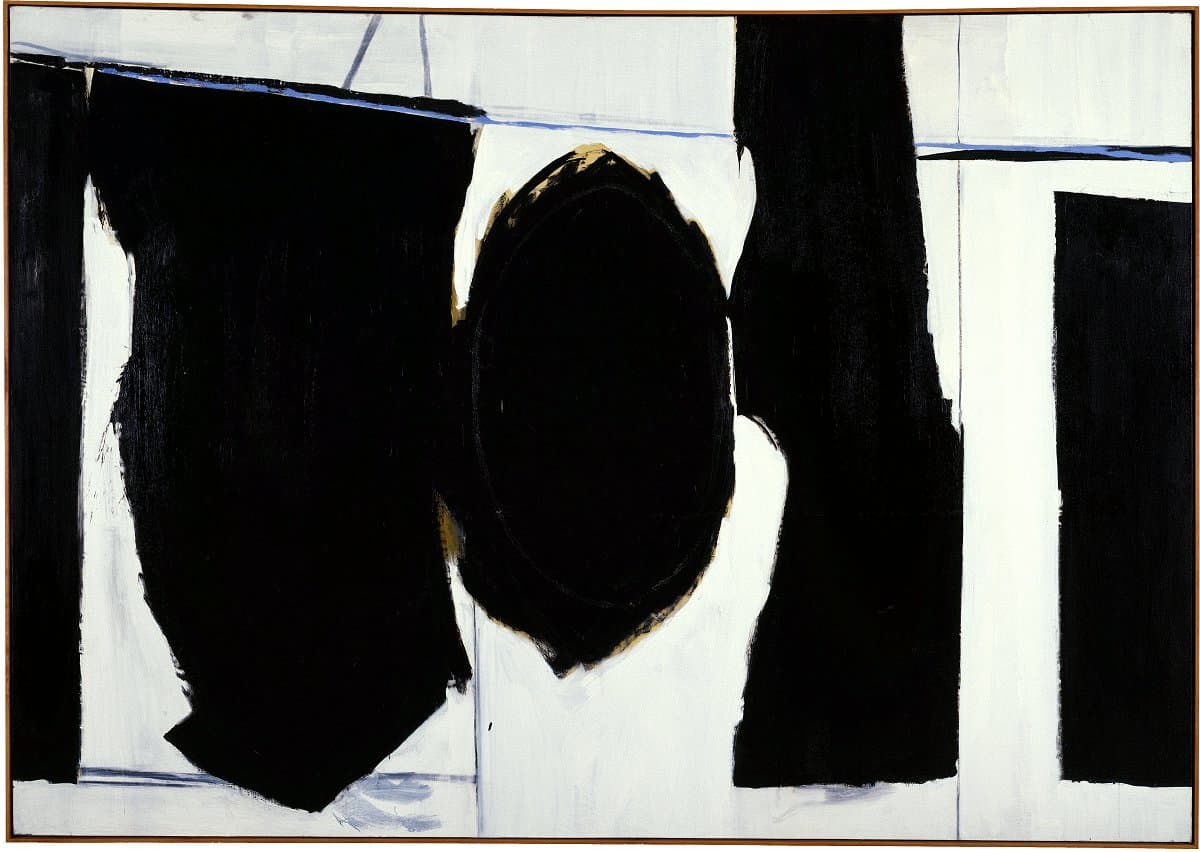

Robert Motherwell
Learn moreElegy to the Spanish Republic 1958
© Dedalus Foundation, Inc. VAGA/Copyright Agency Purchased with the assistance of American Friends of the National Gallery of Australia Inc., New York, NY, made possible with the generous support of The Dedalus Foundation and the Foundation of the National Gallery of Australia 1994
More detail | PermalinkRobert Motherwell played a significant role in the development of postwar American art, and is often regarded as a bridge between European ideas and the New York School. Through his association with the exiled Surrealists, Motherwell came to envisage a way forward for American art that embraced ideas from this movement, such as ‘automatism’, meaning that imagery should be spontaneous and not premeditated. This is apparent in Elegies to the Spanish Republic, the collective title used by Motherwell from the early 1950s to describe a body of work that occupied him for over 40 years. Numbering more than 170 works, of which the Gallery’s Elegy to the Spanish Republic 1958 is indicative, the Elegies mark one of Motherwell’s major contributions to twentieth-century art. As he later commented:
Making an Elegy is like building a temple, an altar, a ritual place … Unlike the rest of my work, the Elegies are, for the most part, public statements. The Elegies reflect the internationalist in me, interested in the historical forces of the twentieth century, with strong feelings about the conflicting forces in it …[1]
The recurring motif that defines the Elegies to the Spanish Republic first appeared in a 1948 black and white pen and ink drawing.[2] This, and the other works that followed, may be seen as Motherwell’s attempt to find a ‘visual equivalent’ to the poetry of Federico García Lorca with its universal themes of life and death.[3] As Motherwell reworked the elegy motif, he expanded the boundaries of its meaning. It became, as Joan Banach explains, ‘a vehicle for representing various rituals of mourning, charged by the unbounded potential and power he recognized in García Lorca’s poetic conception of pena negra or literally, “black grief.”’[4] For Motherwell, black had an eloquent and talismanic power. In Elegy to the Spanish Republic, the black forms march across the canvas, the traces of ochre underpainting evident around the central oval and the single, sky-blue horizon line the only concessions to colour.
By the late 1950s Motherwell had completed more than 50 Elegies. In the spring of 1958 he married painter Helen Frankenthaler and, during the summer, they rented a villa in St Jean-de-Luz, France, near the Spanish border. It was the first time that Motherwell had visited Spain and, in the ensuing period of frenetic activity in Europe he painted his Iberia series. Elegy to the Spanish Republic, which is uncharacteristically unnumbered, was probably painted in the second half of that year, after the artist returned from Europe, perhaps with a renewed commitment to the series.
Elegy to the Spanish Republic is particularly interesting because it is one of the first of the Elegies in which the artist used Magna rather than oil paint.[5] This brand of acrylic paint was known for its high concentration of pigment, meaning it retained an intensity of colour even when thinned. A new formula of Magna, introduced in 1958, had a consistency closer to that of oil paint, which may have encouraged Motherwell to try the medium. The painting thus marks the beginning of a new phase, in which the artist explored the subtleties of a new medium within the established imagery of the Elegies. Motherwell kept this Elegy to the Spanish Republic in his studio until his death.
Steven Tonkin
[1] Quoted in Jack D Flam, ‘With Robert Motherwell’, in Robert Motherwell, Abbeville Press, New York, 1983, p 22.
[2] Motherwell drew the image to illustrate a poem by writer and critic Harold Rosenberg in the second (and unpublished) issue of the periodical Possibilities. HH Arnason, ‘Robert Motherwell: The years 1948 to 1965’, Art International, vol 10, no 4, 20 April 1966, p 25.
[3] As Arnason commented, Lorca’s poetry rekindled Motherwell’s youthful idealism and passion for the cause of the Spanish Republic whose demise had a significant impact on Motherwell’s generation; see HH Arnason, Robert Motherwell, Harry N Abrams, New York, 1982, 2nd and revised ed, p 30.
[4] See Joan Banach, ‘Annotated catalogue’, in Motherwell, Fundació Antoni Tàpies, Barcelona, 1996, p 94; this observation was made about Motherwell’s early Elegy series painting Catalonia 1951, held in The Saint Louis Art Museum, Missouri.
[5] Magna acrylic paint was invented by Leonard Bocour and was the brand with which a number of major American artists experimented in the late 1950s.

